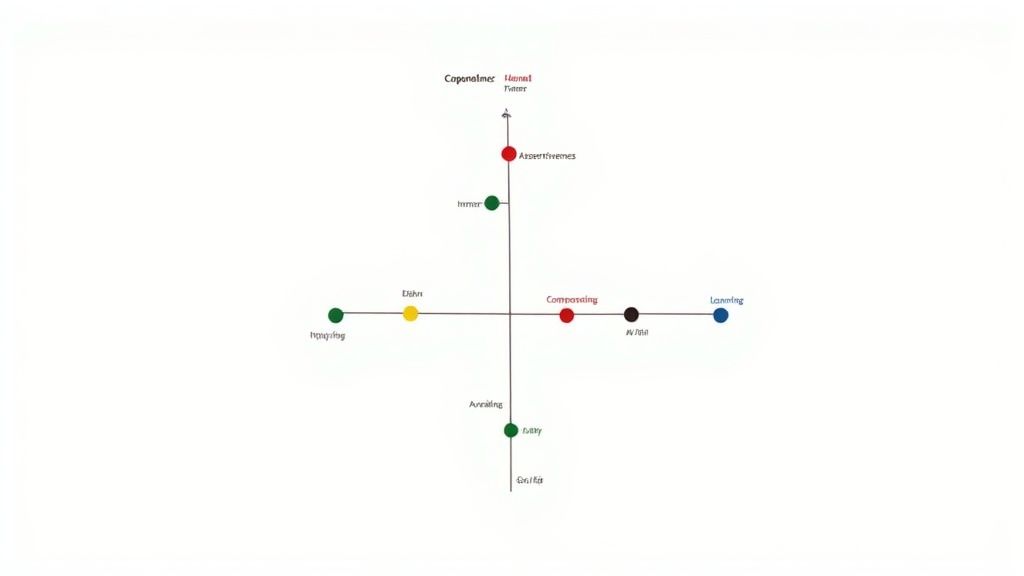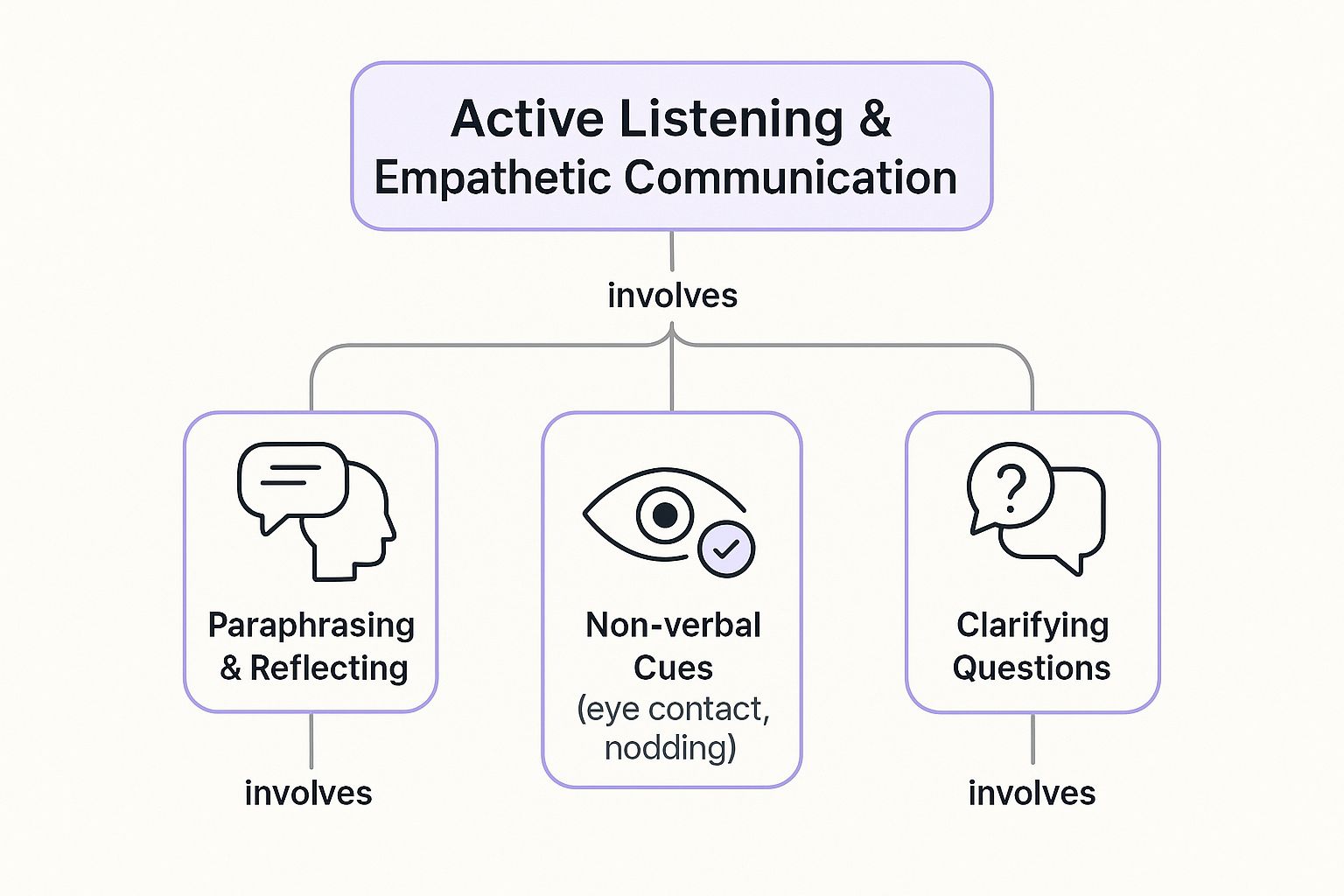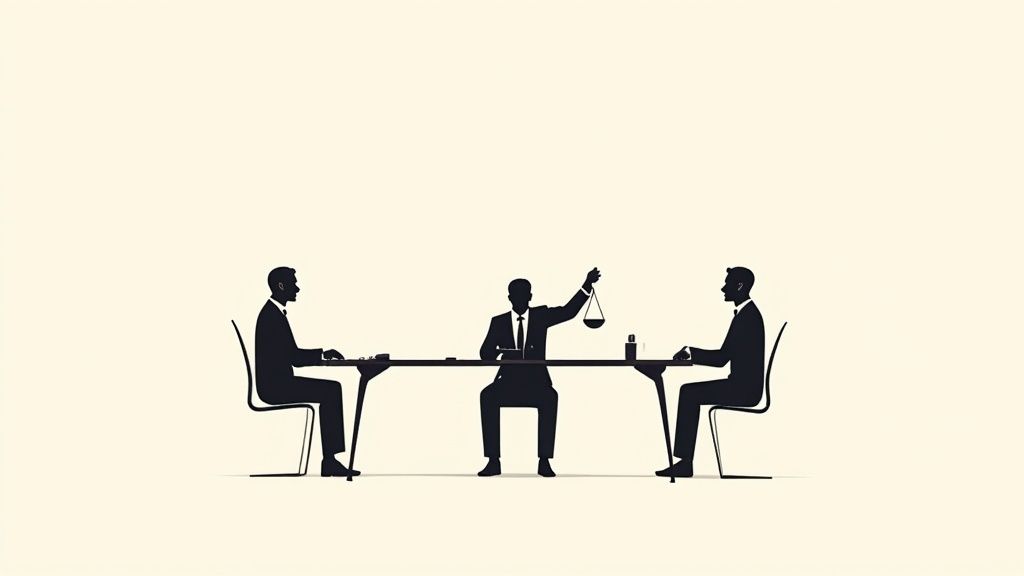
Let’s be honest. Most 'conflict resolution techniques' you find online sound like they were written by a corporate robot who’s never seen two engineers argue about code deployment at 2 AM. It's all 'foster synergy' and 'embrace dialogue.' Useless. I’ve seen simmering disagreements kill more productivity than a week-long AWS outage. I've watched brilliant people walk away from great jobs not because of the work, but because of unresolved friction with a colleague.
We spend fortunes on ping-pong tables to build culture, but ignore the one thing that truly defines it: how we handle tension. A crucial step in preventing conflict from becoming 'the silent killer' is proactively implementing strategies on how to create a positive work environment. But when disagreements inevitably happen, hope is not a strategy. Hope you enjoy watching your best talent walk out the door, because that’s what happens when you treat conflict like it’ll just resolve itself. It won’t.
Over the years, I’ve tried everything from forced happy hours to HR-mandated Kumbaya circles. Most of it was a waste of time. But a few practical conflict resolution techniques workplace managers can actually use stuck. Not because they were fancy, but because they worked in the messy, high-stakes, real world. So, forget the generic advice. Here are the battle-tested techniques I’ve personally seen turn toxic standoffs into productive breakthroughs. No fluff, just what works.
Before you jump into complex negotiation frameworks or bring in a mediator, the most powerful (and criminally underrated) conflict resolution technique is simply shutting up and listening. Active listening isn't just about not talking; it's about making the other person feel heard and understood. It means temporarily shelving your own brilliant arguments to fully absorb their perspective, emotions, and what they aren't saying.

When you practice active listening, you’re not just gathering intel for your rebuttal. You're creating psychological safety, which transforms a confrontation into a collaboration. Big players get this. Google's 'Search Inside Yourself' program heavily features mindful listening to cut down on team friction, and Zappos trains its reps in empathetic listening to de-escalate everything from customer complaints to internal disputes. It's the foundational skill that makes every other technique possible.
If you think there's only one "right" way to handle a workplace dispute, you're bringing a butter knife to a sword fight. The Thomas-Kilmann Conflict Mode Instrument (TKI) is a strategic framework that moves beyond a one-size-fits-all approach. It maps out five distinct conflict styles based on two key dimensions: how assertive you are in getting your own needs met, and how cooperative you are in helping others get what they want.

This isn't just academic theory; it's a practical playbook for navigating human friction. Consulting giant PwC includes TKI in its training to help teams navigate tricky client relationships, while Johnson & Johnson uses it in leadership development to create more versatile managers. Understanding that your go-to style might not fit every situation is the first step toward moving from conflict manager to conflict strategist. It transforms workplace conflict resolution from a guessing game into a calculated decision.
When a conflict feels like a zero-sum game of tug-of-war, you're probably arguing about positions, not interests. The Interest-Based Relational (IBR) approach, famously honed by the Harvard Negotiation Project, is a game-changer. It forces you to stop fighting over what you want (your position) and start uncovering why you want it (your underlying interest). It’s the difference between two departments fighting over the last slice of the budget versus figuring out how to achieve both of their core goals together.

This isn't just academic theory; it's a battle-tested strategy for untangling complex workplace knots without torching relationships. Pixar's legendary 'Braintrust' meetings use these principles to critique films, ensuring creative disagreements lead to a better movie, not a fractured team. Similarly, Amazon's "Have Backbone; Disagree and Commit" leadership principle is pure IBR: it encourages robust debate based on interests, not egos, to find the best path forward. It’s one of the most effective conflict resolution techniques workplace leaders can master because it turns adversaries into problem-solving partners.
Sometimes, two people are just too entrenched to talk it out. Their direct communication lines have become so tangled with emotion and history that every conversation is a dead end. That’s when you need to call in a referee. Mediation is the structured process of bringing in an impartial third party to guide the conversation, not dictate the outcome.
This isn't about finding a judge; it's about finding a facilitator who can lower the temperature and help both sides explore solutions they couldn't see on their own. The United States Postal Service runs one of the world's largest workplace mediation programs, resolving over 15,000 disputes annually with an 85% success rate. Similarly, the BBC cut its employment tribunal cases by 40% after establishing its own mediation service. When done right, mediation isn't just a conflict resolution technique; it’s a litigation-prevention machine.
If you're tired of zero-sum games where someone always leaves feeling like they lost, it's time to stop compromising and start collaborating. Collaborative problem-solving isn't about meeting in the middle; it's about baking a bigger pie so everyone gets a satisfying slice. It transforms a 'me vs. you' showdown into an 'us vs. the problem' workshop, forcing a crucial mindset shift from defending positions to exploring shared interests.
This isn't some fluffy, Kumbaya concept. It's a pragmatic engine for innovation. IDEO weaponizes this approach, turning design disagreements into breakthrough products. Toyota's entire 'kaizen' philosophy is built on factory-floor collaboration to solve production conflicts. The goal is to find a brilliant third option that no one had considered before, moving beyond the initial demands to address the underlying needs of everyone involved. It’s one of the most powerful conflict resolution techniques workplace leaders can deploy.
When a conflict feels like a tangled mess of accusations and emotions, you need a tool that cuts through the noise. The DESC Script Model is that tool. It’s a structured communication framework that turns a potential shouting match into a productive, step-by-step conversation. Forget vague complaints; this is about precision-guided feedback.
The DESC script (Describe, Express, Specify, Consequences) forces you to get your thoughts in order before you even open your mouth. It’s an incredibly effective conflict resolution technique for the workplace because it shifts the focus from blaming a person to solving a problem. It’s no surprise that high-stakes environments, like healthcare, use it to address safety concerns between staff, and companies like SAP build it into their assertiveness training. It’s your script for saying what needs to be said without blowing things up.
When the same annoying conflict keeps popping up like a bad sequel, you’re not dealing with a personality clash. You’re dealing with a broken system. Instead of slapping another HR-approved bandage on the problem, you need to get out a shovel and dig. This is where Root Cause Analysis, particularly the 'Five Whys' technique, shifts from a manufacturing buzzword to a conflict resolution superpower.
Pioneered by Toyota, the idea is simple: ask "why" about five times to move past the surface-level drama and uncover the systemic flaw that’s actually causing the friction. Amazon's "Correction of Error" process is built on this logic, forcing teams to diagnose operational failures rather than just blaming the last person who touched the project. It transforms the conversation from a finger-pointing session into a collaborative investigation, making it one of the most effective conflict resolution techniques workplace managers can deploy.
Sometimes a one-on-one chat won't cut it, especially when a conflict has rippled out and damaged the entire team's trust. For these bigger, messier situations, you need to pull out a more powerful tool: the Restorative Justice Circle. Forget punitive finger-pointing. This technique, adapted from indigenous peacemaking traditions, is about bringing everyone affected by a conflict together to collectively address the harm, not just the rules that were broken.
This isn't just some fluffy HR exercise. It's a structured process focused on understanding impact, taking responsibility, and collaboratively repairing relationships. Ben & Jerry's famously uses restorative practices to build its social justice workplace culture, and government bodies like the City of Minneapolis use circles to resolve team conflicts after critical incidents. When done right, it's a profound way to turn a trust-shattering event into a moment of team healing and a stronger, more resilient culture.
| Conflict Resolution Method | Implementation Complexity | Resource Requirements | Expected Outcomes | Ideal Use Cases | Key Advantages |
|---|---|---|---|---|---|
| Active Listening and Empathetic Communication | Low to moderate (requires practice) | Minimal; primarily time and emotional effort | Builds trust, reduces defensiveness, lasting solutions | Everyday conflicts, team communication | Cost-free, builds rapport, identifies root causes |
| The Thomas-Kilmann Conflict Mode Instrument (TKI) | Moderate (assessment and training needed) | Assessment tools and training resources | Better conflict style awareness, flexible conflict handling | Leadership development, team conflict management | Research-backed, flexible, measurable insights |
| Interest-Based Relational (IBR) Approach | Moderate to high (needs skill & time) | Skilled facilitators, time for negotiation | Stronger relationships, creative and sustainable solutions | Negotiations, preserving relationships | Focus on underlying interests, reduces deadlock |
| Mediation with Neutral Third-Party Facilitators | High (requires trained mediators) | Budget for mediators, private space | Mutually acceptable solutions, reduces escalation | High-emotion conflicts, broken communication | Structured, confidential, higher commitment |
| Collaborative Problem-Solving | High (requires facilitation & time) | Time investment, facilitation skills | Innovative, comprehensive solutions, stronger relationships | Complex problems, long-term collaborations | Win-win focus, builds trust, encourages creativity |
| The DESC Script Model | Low (easy to learn) | Minimal; preparation time | Clear, respectful communication, reduced defensiveness | Performance feedback, ongoing issues | Structured, reduces anxiety, behavior-focused |
| Root Cause Analysis and the 'Five Whys' Technique | Moderate (requires analysis skill) | Time for investigation, collaborative effort | Identifies systemic issues, prevents recurrence | Recurring conflicts, process/system problems | Objective, avoids blame, enables lasting change |
| Restorative Justice Circles | High (time and skilled facilitation) | Skilled facilitators, extended time commitment | Accountability, relationship repair, empathy-building | Misconduct resolution, rebuilding trust | Inclusive, addresses emotional harm, culturally responsive |
Alright, let's be real. We’ve just walked through a whole menu of sophisticated conflict resolution techniques workplace leaders should know, from the diagnostic power of the TKI to the surgical precision of the DESC script. But knowing the techniques is like owning a set of fancy wrenches; they’re useless until you actually get your hands dirty and use them.
The biggest mistake isn't picking the wrong technique. It's doing nothing at all. Avoiding conflict doesn't make it disappear; it just marinates, turning a small, fixable issue into a toxic mess that tanks morale and kills productivity. The goal isn’t to create a conflict-free utopia where everyone agrees all the time. That’s a pipe dream. The real goal is to build a conflict-resilient culture, one where your team can disagree passionately and emerge with stronger ideas and deeper respect.
So, where do you go from here? Don't try to boil the ocean.
Mastering these skills isn't just about playing referee or keeping the peace. It's a powerful retention strategy. The best talent, whether they’re down the hall or a remote developer you hired from a top-tier global pool, craves psychological safety. They want to know they can raise red flags, challenge bad ideas, and voice dissent without risking their reputation or their job.
When you prove you can navigate conflict constructively, you’re sending a clear signal: this is a place for grown-ups. This is a place where the best ideas win, not the loudest voices. It shows you’re building an organization that’s robust enough to handle the friction that inevitably comes with innovation and growth. So stop seeing conflict as a problem to be squashed and start seeing it for what it is: an opportunity to lead. Now, go have that difficult conversation you’ve been dreading. You’ve got the tools.
